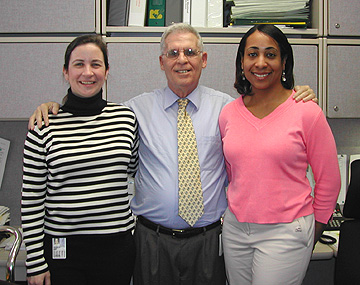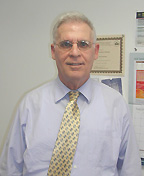
| T H E N I H C A T A L Y S T | M A Y – J U N E 2005 |
|
|
|
OTT and Rotavirus VaccineTHE SHOT HEARD 'ROUND THE WORLD |
by Fran Pollner |
 |
|
Technology
licensing specialists Susan
Ano (left) and Chekesha
Clingman (right) round out the core team headed by Uri Reichman, chief
of the OTT Infectious Disease Branch, that has devised the questionnaire
and conducted negotiations with prospective rotavirus vaccine manufacturers
|
 |
|
Licensing
branch chief Uri Reichman
|
In the transformation of the rotavirus vaccine landscape from deserted to populous, Uri Reichman sees much to applaud.
"The more competition, the better," says the NIH Office of Technology Transfer infectious disease branch chief who has been the primary contact for the 10 companies thus far that have signed agreements with NIH or are nearing completion of negotiations to secure the right to pursue approval of rotavirus vaccines developed by NIH researchers.
"The more participants, the better for public health," Reichman said in an interview, "because there is plenty of need to go around. This vaccine is needed by infants in every little corner of the world."
And because the market is so large and potentially profitable—and previous doubts about the vaccine’s safety have been answered (see main story)—there may be more manufacturers seeking a license than is typical in a generally vaccine-wary climate.
Their interest, however, is not enough. Reichman’s office has devised a detailed questionnaire to ascertain the resources, experience, and expertise of the companies seeking a rotavirus vaccine license. Each applicant must also submit a comprehensive development plan.
It was BIOVIRx, of Shorefield, Minn., that started the march back to the live-virus oral vaccine first marketed as RotaShield.
"BIOVIRx had followed the literature [challenging the reports of increased intussusception risk] and approached us with their intention to revive the vaccine and launch it in developing countries," Reichman said. He noted that his office had attempted in 2003 to convince Wyeth, the original RotaShield licensee, to act on the new data and bring RotaShield to market again.
"It was still an approved vaccine; the FDA had never reversed its approval or revoked Wyeth’s license to market the vaccine. But Wyeth would not involve itself further," Reichman recalled.
Termination of the OTT license agreement with Wyeth cleared the way for other interested parties to seek intellectual property rights and with them the go-ahead to produce and test the vaccine to gain approval from the FDA or regulatory agencies in other countries.
Wyeth shipped back to NIH all materials related to the RotaShield license and its CRADA involving research on both the rhesus-human and the bovine-human rotavirus reassortant vaccines developed by Al Kapikian and his NIAID team. These included 183 boxes of documents and other materials such as viral strains; all have been safely stored and will be shipped to new licensees as warranted.
After BIOVIRx, nine more companies have entered the field, all seeking to market the second-generation bovine-human rotavirus vaccine.
The first applicant, also a U.S. company, sought to secure exclusive worldwide rights. As is standard procedure, OTT put a notice in the Federal Register that a qualified company had requested and, absent objections, would be granted an exclusive license for that particular vaccine.
In a sense, the Federal Register serves as a marketing tool for OTT, Reichman commented. A notice there alerts interested companies to the fact that an NIH invention is now available for licensing, and it invites qualified parties to apply.
In the case of the bovine-human rotavirus vaccine, eight more companies applied and qualified for licenses—four based in India, three in China, and one in Brazil.
The Brazilian license, with the Butantan Institute of São Paulo, was concluded in February 2005 (see main story) at an on-site ceremony in which Luis Salicrup, OTT senior advisor for global licensing, participated. Negotiations with the others were near conclusion at NIH Catalyst press time. Reichman expects all will be signed by September.
In addition to the NIH vaccines, Reichman said, there are two other rotavirus vaccine products in clinical trials and "close to launch." One, by Merck, is a pentavalent bovine-human reassort-ant vaccine similar to the NIH bovine-human design; the other, by GlaxoSmithKline, is a monovalent human attenuated strain vaccine.
The immensity of the market, Reichman said, ensures each manufacturer a healthy return on its investment—as well as royalties for NIH.
More important, he said,
the more manufacturers there are, the larger the hedge against inadequate supplies
in the event of spoiled vaccine lots, which is occasionally bound to happen
but will not be calamitous if there is more than one lone supplier. ![]()